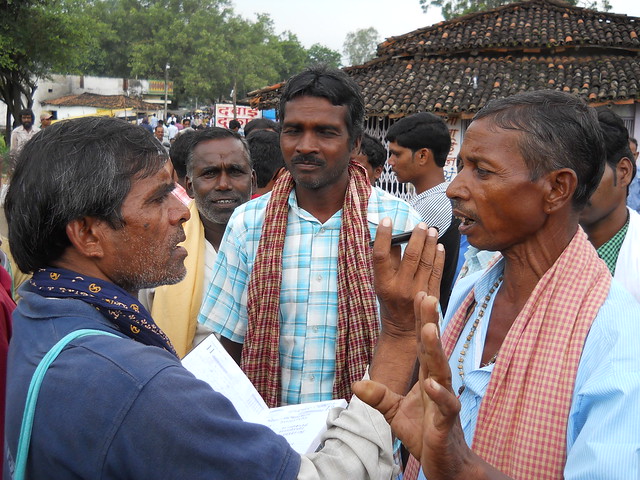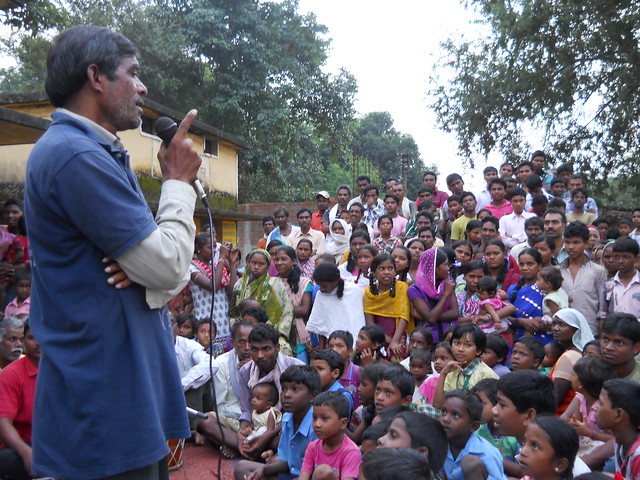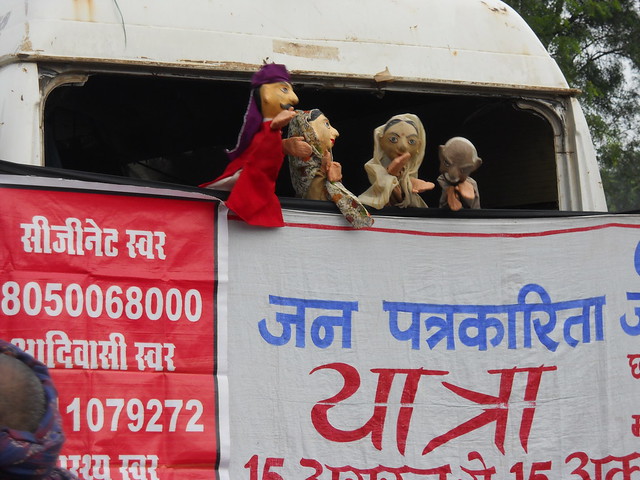By Aishik Chanda,
Kukurbhukka, Jashpur district (Chhattisgarh): They travel in a van donated by a Gondi Adivasi organization of Bastar. They spend the night with benevolent villagers and eat whatever is offered. The 12-member CGNet Swara team that travels through central India promoting citizen journalism through mobile radio is a diverse lot.
The team has hardened tribal activists from Madhya Pradesh and Chhattisgarh against whom sedition charges were pressed, teenage boys and girls, who want to bring a change in the lives of the adivasis, a college student who loves photographing people, folk singer from Muzaffarpur (Bihar), who records folk songs, and a puppet artist from Varanasi (Uttar Pradesh), who feels his talent is not getting due recognition.

CGNet activist Gokaran Singh Verma teaching an Adivasi at a weekly haat in Jashpur district how to report through mobile.
But despite the diversity, there is a common thread. All the members, with dreams in their eyes and a steel-firm will, believe in Gandhian ideals of ‘Gram Swaraj’ and ‘non-violence’. Also, they believe that the tribals of central India need not take up arms as a response to the state oppression.
“Education and self-reliance are what the adivasis in the Maoist zones need. We want the people here to become strong enough to fight non-violently for them-selves. We want to make them bolkaars (voice journalists) so that they can fight directly with the state for their rights, albeit through the mobile phone,” said Gokaran Singh Verma, a former Ekta Parishad member – who had walked over 85,000 km throughout the country as part of the Ekta Parishad rallies in the mid 90s. Formed in 1991 by ex-IAS officer Rajagopal PV, the Ekta Parishad has fought for land rights of central Indian Adivasis.
The CGNet Swara team uses the puppetry and nukkad nataks (street plays) at different villages and the weekly haats to drive home the complex system of ‘reporting using the mobile phone’. The end-user – here an adiwasi – calls a Bengaluru number but the call gets cut immediately and he receives a call back. He/she needs to press ‘1’ for recording a message and ‘2’ for listening to a message. The caller gets three minutes to record his/her message and give the name and number of the authority concerned, in most cases the collector. After moderation at the CGNet HQ at Bhopal, the message is uploaded at the CGNet website.
The interesting part starts then. Callers from all over India, including metro cities such as Mumbai and Delhi, call the collector or the official concerned, whose number has been given, and ask him/her to immediately rectify the issue. Most of the time the collector gets vexed over the phone calls and takes some action immediately.
“Problems that were not solved since 20 years have been solved within 5 days due to the phone calls,” claims CGNet activist Charan Singh Parte from Mandla, MP.

The initiative, led by former BBC South Asia producer Shubhranshu Choudhary, has received the Knights International journalism award in 2013.
When asked whether the state or Maoists pose any problem to the activists of CGNet, Choudhary said they had earlier faced problems from the state but that has changed now while the Maoists never disturbed.
However, not all Gandhians have been treated non-violently by the state. Several of them were arrested by the police on charges of sedition and had to undergo third degree torture. Bunkar, a hardened tribal activist who fought for land rights to Baiga adivasis who were evicted off the buffer zone at the Kanha tiger reserve, said, “The state had termed me Maoist and even pressed sedition charge against me for my work among adivasis. However, they couldn’t prove any charge. It’s a general tendency of the state to brand any activist working for the adivasis, as a Maoist. This is not justified. We are Gandhians and abhor violence. Why should we be branded Maoists?”
The CGNet Swara gets most of its support of organizing meetings and shows to propagate mobile journalism with the help of Ekta Parishad members spread to the remotest villages of Chhattisgarh. The Ekta Parishad members give a list of the most neglected villages and the CGNet team plans its ‘CGNet Yatra’ accordingly with an aim to reach out to as many adivasis as possible. The 12-member team carried out a more than one month long Yatra in Chhattisgarh recently. Apart from individual villages, the CGNet activists choose weekly tribal haats, where people from over 20 villages, on an average, meet.
The CGNet team conducts its puppet show; teach the people how to record their news through the mobile and also how to transmit it. They also use the age-old method of disseminating information, through pamphlets and rely on the word of mouth publicity too.
During the yatra, the CGnet team is exposed to the real problems of the tribals – from non-implementation of MNREGA scheme to demolition of houses for mining by corporates. The team has also come across places people rarely have heard of and experienced things that they couldn’t have imagined, said Sunil Kumar, a CGNet activist from Bihar who earlier worked in the Gaon Jawar Sansthan (a Gandhian organization based in Bihar).

“We have bathed in ponds, dam reservoirs, streams and even puddles in paddy fields. We have eaten whatever the villagers offered us. Sometimes, we saw that when the pulses and vegetables in a particular household got over, the hosts ate rice with salt and chilly but fed us with the best they had. These moments bring tears to our eyes and motivate us to work much more for these forgotten people,” said Harshit Charles, photographer of the team, who is in the final semester of his college at Balaghat (Madhya Pradesh). He dreams of joining the Media and Cultural Studies course at the Tata Institute of Social Sciences, Mumbai to learn videography and use that skill to document the medicinal, cultural and traditional knowledge of the adivasis.
“These yatras have taken us to the most godforsaken land, where even “khaki wardi waale (security personnel) think twice before entering. But, this exposure has brought us closer to the people,” says Kalwati Gadewal, one of the three female members of the team.
—–
(Former journalist with The New Indian Express and Deccan Chronicle at Hyderabad, the author is currently pursuing M.A. Dalit and Tribal Studies and Action at the Tata Institute of Social Sciences, Mumbai. He continues to write as an independent journalist).

